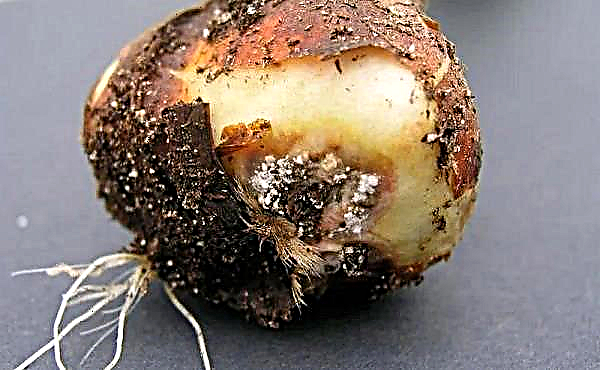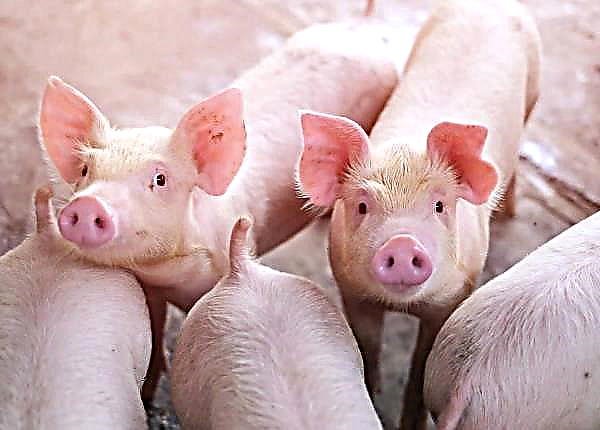Sheep husbandry is attracting an increasing number of novice farmers, appreciating the benefits of raising these animals in their farm. However, improper care can lead to serious illness and loss of livestock, resulting in financial loss. In particular, an important point is the vaccination of sheep, the details of which every sheep breeder should know.
Sheep vaccination: why and how often to do
Sheep vaccination is a mandatory preventive measure that helps protect animals from serious infectious diseases. The fact is that when a virus enters the body for the first time, the immune system quickly produces antibodies to fight. A vaccine is also a virus, only in a weak form. Its main task is to “teach” the body to cope with danger. If you do all the necessary vaccinations, the sheep’s body will be ready for protection in the event of a possible attack of an infection, and there are many dangers.

Sheep and rams - herd animals, therefore, the advantage of vaccination lies in the fact that it protects not only one individual, but also others. If 80–90% of the herd is vaccinated - the infectious disease will not spread - collective immunity will work. Thanks to vaccinations that have been carried out for more than 100 years, the spread of such serious diseases as anthrax, rabies, smallpox, etc., has been significantly reduced.
Did you know? The vaccine was first used on animals at the end of the 19th century. Its composition was developed by the French microbiologist Louis Pasteur, who is the founder of the science of immunology.
Vaccines are being prepared at special plants from microbes and their metabolic products. Vaccinations are made by veterinarians, who keep records, and also make sure that the established schedule is observed, depending on the age of the animal. On all vaccinated animals, inventories are compiled, which are stored in the veterinary department for 2 years.
Immunity after vaccination occurs, as a rule, after 10 days and lasts about a year. After vaccination, minor side effects may be observed: swelling at the injection site, fever. This is not worth fearing - the symptoms will disappear in 2-3 days.

Vaccination schedule
It is more profitable for any owner to buy a vaccine and vaccinate the animal on time, than to incur losses in its treatment or slaughter (many diseases proceed lightning fast, so late help may no longer be effective). “A pound of prevention is worth a pound of treatment,” are the words of the great scientist Pirogov, which are fully true.
Despite the fact that veterinarians follow the schedule, owners of small cattle should also be aware of the vaccination schedule and not miss the next vaccinations against diseases such as rabies, smallpox, brucellosis, anthrax, bradzot, tuberculosis, tetanus.
Important! Before vaccination, the animal must undergo a thorough medical examination. It is forbidden to vaccinate clinically debilitated and sick animals.
Newborn lambs
Newborn lambs need immunity against dysentery, especially in areas where it can progress. To develop it, they vaccinate a pregnant sheep. The first vaccination is carried out 3-4 weeks before lambing, and the second 10 days after the first.
The procedure must be carried out carefully to avoid mechanical abortion. As a result of such a double vaccination, an active immunity is formed in a vaccinated sheep. Newborn lambs receive passive immunity through milk.

At the age of 1 month, the lambs receive a vaccine against leptospirosiswhich is repeated after 6 months. If the sheep who gave birth to the lamb was vaccinated the day before, the newborn will remain immune for 1.5 months after birth, so the first vaccine can be administered no earlier than this age.
Lambs and young animals
When a lamb reaches the age of 3 months, he is vaccinated against anthraxwhich is then repeated six months later. At 10-12 weeks of age, they are vaccinated against rabies, with a regular repetition of the procedure after a year.
Starting out from 3 months, smallpox vaccine is introduced to young animalswhich is repeated after 14 days and then revaccinated after 6 months. According to a similar schedule, they are vaccinated against the plague.
 Young bright sheep aged 3-5 months are vaccinated against the threat of brucellosis. Immunity lasts for 2 years, then revaccination is necessary.
Young bright sheep aged 3-5 months are vaccinated against the threat of brucellosis. Immunity lasts for 2 years, then revaccination is necessary.
To adults
Adults are vaccinated without fail 2 times a year - in the spring and in the fall from anthrax, bradzot infection, enterotoxemia. Adult smallpox vaccinated every year. To prevent the risk of plague, adult sheep and rams are given the appropriate vaccine every 3 years.
Adults are vaccinated against leptospirosis once a year. From such serious ailments as infectious hepatitis, tetanus, vaccinations are also given with an interval of 1 year. For adults, a brucellosis vaccine is administered once every 2 years for 6 years. If the region where the animals are located is disadvantaged and the risk of infection is quite high, the vaccination rate can be increased up to 1 time per year.
Important! After vaccination, animals develop immunity after 12–14 days. During this period, it is important to provide them with favorable conditions and high-quality nutrition, not to bathe, and to ensure that individuals do not overcool.
Disease
There are quite a few diseases that can affect sheep. Among them are distinguished:
- non-contagious - non-transmitted diseases, often caused by improper care (arthritis, bronchopneumonia, conjunctivitis, etc.);
- parasitic - timely disinfection of pastures and stalls (tick-borne encephalitis, helminthiasis, psoroptosis) will help to avoid the danger of a disease with them;
- infectious - The most severe type of disease, most of which are difficult to treat.
Infectious diseases require prophylactic vaccination of animals at different stages of growth. Sheep farmers must know the main symptoms of the disease in order to be able to take action on time.

Smallpox sheep
Smallpox is an acute illness that is transmitted very quickly by airborne droplets, as well as through feed, manure, and animal care items. Smallpox is characterized by intoxication phenomena, shortness of breath, fever, the appearance of a papular rash on the skin and mucous membranes (first on the head, lips, and then on the inner surfaces of the limbs). Mortality from this disease is very high, especially in young animals.
 A sick animal is isolated from the herd, provide good care for him. For treatment, antibiotics, ointments, softening smallpox are used, ulcers are cauterized with iodine solution
A sick animal is isolated from the herd, provide good care for him. For treatment, antibiotics, ointments, softening smallpox are used, ulcers are cauterized with iodine solution
Anthrax
An extremely transient disease that is instantly transmitted to other sheep and sheep, as well as to humans. The microbial pathogen enters the body of the animal with food, water or infected grass. The disease manifests itself with ulcers on the body, cyanosis of the eye membranes, high fever. With lightning fast, death cramps are possible.
 It is impossible to cure the disease on your own - it will require veterinary care. The animal is injected with serum, injected with gamma globulin and penicillin antibiotics
It is impossible to cure the disease on your own - it will require veterinary care. The animal is injected with serum, injected with gamma globulin and penicillin antibiotics
Rabies
One of the most dangerous diseases that does not have an effective treatment is that the animal is isolated from the herd and killed. The disease affects the central nervous system, transmitted through saliva. It manifests itself in the early stages with a hoarse moo, loss of appetite, and improper coordination of movements. In later ones - increased aggression, inflicting severe injuries to oneself, throwing on a leash. The danger also lies in the fact that not only her fellow tribesmen, but also humans can become infected from a rabid sheep.

Plague
Plague in sheep and rams proceeds predominantly acutely. You can determine it by such symptoms as ulcerative lesions of the mucous membranes, including conjunctivitis, as well as the development of pneumonia. The disease is transmitted through the respiratory tract and directly through contaminated feed, animal care items.
Did you know? Plague-infected animals were used as biological weapons in the Middle Ages. Their bodies were infected by water sources and water supply systems.
The method of curing the disease has not been developed. In case of detection of a sick individual, they carry out not only its destruction, but also the entire susceptible population.

Leptospirosis
The disease has several forms, including acute, chronic and asymptomatic. In adult animals, it often proceeds without symptoms, and in young animals it is acute. The first signs are fever and the appearance of blood in the urine. The disease is characterized by fever, anemia, jaundice, kidney damage, as well as spontaneous abortions or the birth of a dead fetus.
 An animal infected with leptospirosis is isolated from the herd and treated by injecting streptomycin antibiotic for 5 days.
An animal infected with leptospirosis is isolated from the herd and treated by injecting streptomycin antibiotic for 5 days.
Trichophytosis
Trichophytosis (ringworm) can overtake sheep and rams when they reach two years of age. This severe fungal disease is characterized by the appearance of round hairless spots on the skin, covered with yellow-gray crusts, causing overthrow. In severe form, purulent inflammation of the skin can form. The disease spreads rapidly, can be transmitted to humans.
The fungus is transferred in direct contact with sick individuals during mating, a long touch, as well as with dust, air, drops of water.
 Ill animals are isolated and treated with vaccines that are administered intramuscularly with an interval of one and a half to two weeks. The recovered individual forms a lasting immunity
Ill animals are isolated and treated with vaccines that are administered intramuscularly with an interval of one and a half to two weeks. The recovered individual forms a lasting immunity
Infectious hepatitis
Hepatitis is an inflammation of the liver characterized by fever, damage to the central nervous system. The disease can be asymptomatic or acute. In the first case, the animal dies quickly when seizures occur, and in the second, you can observe an increase in temperature, vomiting, the development of conjunctivitis, and weakness of the hind limbs.
 Antibiotics, symptomatic agents are used as treatment, provide good nutrition to animals
Antibiotics, symptomatic agents are used as treatment, provide good nutrition to animals
Microsporia
Microsporia is an infectious disease, manifested by inflammatory processes of the skin with sprinkling of wool. In sheep, it takes place in two forms - cutaneous and general. It is transmitted through care items, feed, equipment contaminated with wool, as well as through direct contact with sick animals.
 For treatment, the antibiotic Griseofulvin is prescribed, which is given to the animal for 10-15 days, as well as vitamins and salicylic ointment
For treatment, the antibiotic Griseofulvin is prescribed, which is given to the animal for 10-15 days, as well as vitamins and salicylic ointment
Actima
Ectima is an acute infectious disease that affects the mucous membranes of the oral cavity, scalp, limbs, and mammary glands. It is characterized by the appearance of nodules and crusts. For treatment, the drug “Zidofovir” is used - this spray treats the affected mucous membranes and skin areas. Glycerin or 5% iodine solution is also used for processing.

Brucellosis
The peculiarity of this infectious disease is the almost complete absence of symptoms, with the exception of a miscarriage in a pregnant sheep. Infection can be transmitted to humans. When purchasing a new animal, before sending it to the herd, you should check it with your veterinarian for the presence of Brucella bacteria in the body.
In rams, brucellosis manifests itself in the form of an inflammatory process in the testes and their appendages - in these places you can feel small lumps. In such individuals, the reproductive function is significantly reduced.
Raising sheep is an interesting and quite profitable occupation, but only proper care and, of course, timely vaccination of animals will contribute to the increase in the number of livestock, its successful development and healthy generation.












